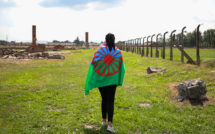

This is part of a Roundtable, Ideas of Race, Ideologies of Racism: Roma Rights in Europe during the #BLM moment.
During the first three months of lockdown in 2020, the European Roma Rights Centre (ERCC) identified twelve countries across Europe in which Roma communities faced movement restrictions or disproportionate impacts from emergency measures despite the lack of evidence of higher case counts in those communities (Kay 2020). For almost a year now, the entire world has seemed united—or, at least commonly shaken—by similar concerns. Throughout this time, the topic monopolizing news channels in Asia, Europe, North and South America, the Caribbean, Africa, and Australia has been the coronavirus, its evolution, treatment, and vaccines. Soon after the outbreak of this latest pandemic, an older yet still ongoing pandemic gained more visibility—racism. After George Floyd was murdered by a white police officer in Minneapolis in May 2020, the debates around the coronavirus were accordingly met with worldwide protests against racism. Initially organized in solidarity with Black people in the US, these protests soon became denunciations of local racism in different parts of Europe and revived longer-standing anti-racism movements in South Africa and South America, among other places. Statues associated with slavery or colonialism were toppled by protesters in the United States, the UK, Belgium, and New Zealand, while in numerous others countries monuments have been contested, spray-painted, torn down, or placed under watch. From the coronavirus to antiracist demonstrations, there seems to be a domino effect from one corner of the world to the other. But is there a common denominator to these events—other than the dizzying speed with which both the virus and the verve of protest have lately spread?
Soon after the coronavirus outbreak in China, Asians were often regarded as “default’ virus carriers. The aftermath of these racist attacks and aggressions saw the emergence of such anti-racist slogans as “I am not a virus” and “Racism is the pandemic.” The studies according to which people of color in the United States, Europe, or South Africa, as well as indigenous populations in Brazil or Australia have been more exposed to the coronavirus and have disproportionately contracted COVID-19 also point to a strong link between the pandemic and existing inequality structures. The pandemic has indeed exacerbated preexistent inequalities, especially with respect to access to resources that become important during a health crisis, such as a medical insurance, comfortable living quarters, or the option to work from home (Oxfam 2021). Racialized populations—groups that have historically experienced racism and exclusion and still do so today— often perform hazardous jobs with no or little health benefits that place them on what, in the war-like terminology of the pandemic, was called the “frontline.” They are also more often that the general population subjected to police violence and targeted by strict lockdown measures during health crises such as the current coronavirus pandemic. At the same time, such strict measures are justified using the racialized stereotypes that pinpoint these groups as different from the majority.
It is at the juncture of these two pandemics—coronavirus and racism—that the Roma as “the European minority par excellence” (El-Tayeb 2011: xxvii) come into focus. Present in Europe for centuries, but still not considered of Europe, the Roma are not part of Europe’s reckoning with either racism or enslavement. Not that such consideration happens systematically, or often—but when it does, it routinely restricts European racism temporally to the Holocaust, conflating racism with antisemitism; and it relegates enslavement spatially to Africa and the Americas, equating enslavement with the transatlantic trade. The Roma fall through these temporal and spatial cracks in Europe’s current politics of memory, which remains incomplete without consideration for the history and the present of anti-Roma racism and for the legacies of Romani enslavement in Europe. When Romani history is approached as European labor history, it illuminates both the parallels with the enslavement of Africans in the transatlantic trade and the racializing tropes and attitudes that make both African-Americans and (European) Roma more vulnerable than other groups to the combined effects of two pandemics—the ongoing racism and the new coronavirus.
Throughout the European East, the enslavement of the Roma started as a practice of enslaving prisoners of war. It took place on the territory of today’s Romania during more than five hundred years, as part of a labor regime with an elaborate infrastructure (Achim 1998). After the settlement of large numbers of Roma in the fourteenth and fifteenth centuries in the principalities of Wallachia and Moldova, enslavement became common there (and sometimes also crossed into Transylvania). Legally distinct from serfdom, slavery developed alongside it in these regions and in some cases continued after serfdom ended. As in the Americas, the enslaved in Moldavia and Wallachia resisted the institution of slavery in a range of ways, predominantly by escaping. Also telling are the parallels with the West European trade in enslaved Africans, who were listed as cargo on ships crossing the Atlantic: one category of the Wallachian law regulating enslavement in the nineteenth century listed “unmoving things and G*s.”[i] The enslaved—often considered as part of a labor unit—belonged to an estate. Like other forms of property, the estate encompassed land, built environments, tools, and animals. In both Wallachia and Moldova, the legal codes of the early nineteenth century regulated the marriage of the enslaved to each other and to free people. Very much like in the case of plantation slavery in American colonies, the law legislated over other aspects of life the enslaved were considered to owe their master: sexuality and reproduction. Detailed accounts of marriage arrangements in both Wallachian and Moldavian law testify to the priorities of enslavers to both manage the reproduction of labor power over time and prevent racial mixing, while explicitly reserving the right to sexually exploit female slaves (Parvulescu and Boatcă 2020). As with enslaved African women in the Americas, the trope of sexual availability and promiscuity added to the racialization of Roma women as inferior, uncivilized beings and, in a circular logic, was in turn used to justify their enslavement. In neighboring Transylvania, Habsburg policies at the end of the eighteenth century also attempted to regulate marriage and child rearing among the Roma, resulting in segregationist policies. In particular, obligatory schooling meant that Romani children were sometimes taken away from Romani families and placed in foster homes, a common practice of imperial and colonial rule throughout the world, aimed at disrupting ethnic, religious, and family ties of imperial and colonial subjects (Parvulescu and Boatcă 2020).
The enslaved in Wallachia and Moldavia were freed in 1855-1856 in the name of Enlightenment policies. A rhetoric of “forgiveness” was deployed throughout the emancipation period, leading to the enslaved being “forgiven” what they owed. As with the abolition of slavery in the Americas, the two principalities offered compensation to owners for their economic loss; no compensation however, was granted to the enslaved. The translation of Uncle Tom’s Cabin into Romanian in 1853 from the French edition of the same year was published with an introduction by one of the leaders of the emancipation movement, Mihail Kogălniceanu, albeit his text was censored by the authorities. Nevertheless, he used that opportunity to place the enslavement of Roms in a world-historical framework, where it indeed belonged (Stowe 1853), and to advocate for both the abolition of slavery and the emancipation of peasants from serfdom (Rădulescu 1955).[ii] Two years later, in 1855, the writer and politician V.A. Urechia published in the abolitionist journal Foiletonul Zimbrului several installments of his unfinished novel Coliba Măriucăi (Măriuca’s Cabin), which drew inspiration from Harriet Beecher Stowe’s novel in depicting Roma enslavement and advocating for its abolition.
Such awareness about the structural similarities of African-American and Roma enslavement has since faded from public discussions and collective memory. Roma history is not part of the school curriculum in Romania or of the self-definition of “Romanianness.” Quite the contrary. In an effort to be included in the notion of proper Europeanness—associated with whiteness, Christianity, and Occidentality―many Romanians routinely mobilize anti-Roma racism in forms that range from denouncing the association of Roma with Romanians as false etymology (Tudor 2018) to violent invectives and behavior towards the Roma and active promotion of school segregation as a way of “protecting” Romanian schoolchildren (Costache 2020, Matache and Bhabha 2020).The coronavirus pandemic acted as a magnifying glass that made anti-Roma racism both more visible and more easily mobilized in the name of safeguarding the health of the “nation.” The first reports of discriminatory restrictions on the mobility of the Roma in the European East made headlines during the first month of various European lockdowns in March 2020 (Krasimirov and Tsolova 2020). Officially, the measures amounting to the de facto building of enclaves and ghettos were legitimized as additional yet necessary steps to reduce the spread of the virus from communities lacking in hygiene and unwilling to respect social distancing. As the service industries throughout Europe closed down in March and April, forcing tens of thousands of migrant laborers from the European East to travel back home, hate speech and racist attacks stigmatizing them as virus carriers by association with the Roma, whether or not they actually belonged to that ethnic group, became rampant (Costache 2020). The racializing trope of contagion runs through all of these instances of exclusion. Whether it is contagion of the European or national body with the “undesirable” Romani ethnicity or that of any healthy body with the virus, the Roma are under constant suspicion. Echoing long-standing racial stereotypes, the perceived threat and constructed fear of contagion connects such exclusions both to the history of enslavement in the region and to the racialization and enslavement of Africans in the Americas.
Towards an equal distribution of the right to remember
During the Black Lives Matter protests directed against the statues of enslavers such as Edward Colston in the UK, the practice of tearing down statues was denounced by critics as a purge of collective memory and as an inadequate means to change the unequal structures or racist attitudes in today’s society. Conversely, supporters of the protest movement and historians commenting the events insisted that collective memory could not only be preserved through monuments, but that tearing them down or removing them did not amount to erasing history. Rather, it meant learning from that history (Blain 2020, Traverso 2020). History’s lessons are first and foremost preserved through written documents, curated exhibitions, and civic education about the political consequences of historical events. Yet, as bitter US-American confederates remarked after the Civil War, history is written by the winners. Written history is power privilege. Today, perspectives and voices making up global history are multiplying, helping to counter, for many regional contexts and phenomena, what Nigerian author Chimamanda Adichie (2009) has dubbed “the danger of a single story.” It is high time for Roma history, as well as Roma voices in sociology, political science, and art to join in. It is urgent for a school curriculum that acknowledges Roma enslavement as Romanian history and as a lasting European legacy to become compulsory. The recent publication of the collective volume “The Romanian Problem. An Analysis of Romanian Racism” (Dorobanţu and Gheorghe 2019), with contributions by Roma and non-Roma authors, is a significant step in this direction, as is the production of the first movies, short films, and theater plays on the topic of Roma enslavement and sexual exploitation—some of them from a Roma perspective (Jude, Aferim 2015; Șerban, Marea Rusine; Șerban, Bilet de iertare).
Written history is thus not synonymous with collective memory. Moreover, both can be amended. At stake is an equal distribution of the right to remember in order to learn from a collective past. In the 1990s, the removal of statues and monuments from the public domain marked the transformation of Eastern European state socialist regimes, as well as a claim to recover the region’s repressed perspective on history. At the same time, several Romanian towns unveiled statues and busts of Marshal Ion Antonescu, who was responsible for the Iași massacre of Jews and the deportation of the Roma population to Transnistria during World War II. The statues were outlawed after international protests, but some still stand on private properties in Bucharest and elsewhere. As long as the violent history that such displays honor is not made an integral part of a critical European politics of memory, there will be no vaccine against the racism pandemic.
Manuela Boatcă is Professor of Sociology and Head of School of the Global Studies Programme at the University of Freiburg, Germany. Her work deals with world-systems analysis, postcolonial and decolonial perspectives, gender in modernity/coloniality, and the geopolitics of knowledge production in Eastern Europe, Latin America, and the Caribbean. She is author of Global Inequalities beyond Occidentalism (Routledge 2016) and of Laboratoare ale modernității. Europa de Est și America Latină în (co)relație, (IDEA 2020). She is co-editor (with Vilna Treitler) of Dynamics of Inequalities in a Global Perspective (Current Sociology 2016). She is currently finishing a book (with Anca Parvulescu) on inter-imperial and transimperial dynamics in twentieth century Transylvania.
References:
Achim, Viorel. 1998. The Roma in Romanian History. Budapest: CEU Press.
Adichie, Chimamanda. 2009. The Danger of a Single Story, TED-Talk
Blain, Keisha N. 2020. “Destroying Confederate monuments isn’t ‘erasing’ history. It’s learning from it”, The Washington Post, June 19, 2020.
Costache, Ioanida. 2020. “Until we are able to gas them like the Nazis, the Roma will infect the nation:” Roma and the ethnicization of COVID-19 in Romania, DOR, April 22, 2020, www.dor.ro/roma-and-the-ethnicization-of-covid-19-in-romania/ (accessed March 15, 2021).
Dorobanțu, Oana and Gheorghe, Carmen, eds. 2019: Problema românească. O analiză a rasismului românesc.Bucharest: Hecate
El-Tayeb, Fatima. 2011. European others: Queering ethnicity in postnational Europe. University of Minnesota Press.
Kay, Goldman Jonah. 2020. Coronavirus pushes Bulgaria’s Roma further into the shadows, politico.eu, available online: https://www.politico.eu/article/coronavirus-pushes-bulgaria-roma-further-into-the-shadows/ (accessed March 15, 2021)
Krasimirov, Angel and Tsolova, Tsvetelia. 2020.: Bulgaria’s Roma say some coronavirus measures are discriminatory, reuters.com, available online: https://www.reuters.com/article/us-health-coronavirus-bulgaria-roma/bulgarias-roma-say-some-coronavirus-measures-are-discriminatory-idUSKBN21B355 (accessed March 29, 2021)
Matache, Margareta, and Bhabha, Jacqueline. 2020. “Anti-Roma Racism is Spiraling during COVID-19 Pandemic.” Health and human rights, 22, 1 (June): 379–382.
Oxfam. 2021. The Inequality Virus. Bringing Together a World Torn Apart by Coronavirus through a Fair, Just and Sustainable Economy, Oxfam Briefing Paper, available online: https://oxfamilibrary.openrepository.com/bitstream/handle/10546/621149/bp-the-inequality-virus-250121-en.pdf (accessed March 31, 2021)
Rădulescu, Andreiu. 1955. Legiuirea Caragea. Bucharest: Editura Academiei Republicii Populare Române.
Stowe, Harriett Beecher. 1853. Coliba lui Moșu Toma. Translated by Teodor Codrescu. Iași: Tipografia Buciumul Român.
Traverso, Enzo. 2020. “Tearing Down Statues Doesn’t Erase History, It Makes Us See It More Clearly”, Jacobin, June 24, 2020, available online: https://www.jacobinmag.com/2020/06/statues-removal-antiracism-columbus (last accessed March 31, 2021)
Tudor, Alyosxa. 2018. The Desire for Categories. Feminist Review Blog. https://femrev.wordpress.com/2018/03/19/the-desire-for-categories/ (accessed March 15, 2021)
Media productions:
Radu Jude (dir.) (2015), Aferim!, https://www.imdb.com/title/tt4374460/?ref_=fn_al_tt_1
Alina Serban (dir.) (2020), Bilet de iertare, https://www.imdb.com/title/tt12831344/?ref_=nm_knf_t1
Alina Serban (dir.) (2018), Marea rusine, https://www.youtube.com/watch?v=EUHgOEsIYBw
Photo: Reichstag building is reflecting in the water of memorial dedicated to the Sinti and Roma victims murdered during the Second World War | Shutterstock




